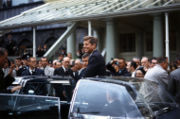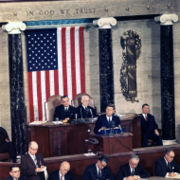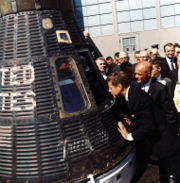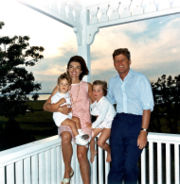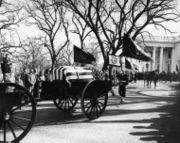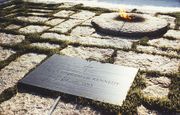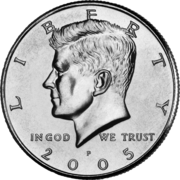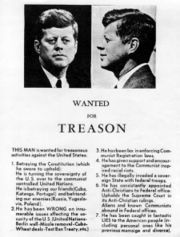John F. Kennedy
2007 Schools Wikipedia Selection. Related subjects: USA Presidents
| John Fitzgerald Kennedy | |
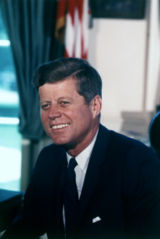 |
|
|
|
|
|---|---|
| In office January 20, 1961 – November 22, 1963 |
|
| Vice President(s) | Lyndon B. Johnson |
| Preceded by | Dwight D. Eisenhower |
| Succeeded by | Lyndon B. Johnson |
|
|
|
| Born | May 29, 1917 |
| Died | November 22, 1963 Dallas, Texas, USA |
| Political party | Democratic |
| Spouse | Jacqueline Lee Bouvier Kennedy |
| Religion | Roman Catholic |
| Signature | |
John Fitzgerald Kennedy ( May 29, 1917– November 22, 1963), also referred to as John F. Kennedy, JFK, John Kennedy, or Jack Kennedy, was the 35th President of the United States. He served from 1961 until his assassination in 1963. His leadership during the ramming of his USS PT-109 during World War II led to being cited for bravery and heroism in the South Pacific. Kennedy represented Massachusetts during 1947–1960, as both a member of the U.S. House of Representatives and U.S. Senate. He was elected President in 1960 in one of the closest elections in American history. He is, to date, the only Roman Catholic to be elected President of the United States.
Major events during his presidency included the Bay of Pigs invasion, the Cuban Missile Crisis, the building of the Berlin Wall, the Space Race, early events of the Vietnam War, and the American Civil Rights Movement.
John F. Kennedy was assassinated on November 22, 1963. The Warren Commission concluded that Lee Harvey Oswald acted alone in killing the president, although later the House Select Committee on Assassinations concluded that a conspiracy may have been involved in the assassination , and the subject remains controversial. Kennedy's assassination is considered to be a defining moment in U.S. history due to its traumatic impact on the nation as well as on the political history of the ensuing decades, his subsequent branding as an icon for a new generation of Americans and American aspirations, and for the mystery and conspiracy allegations which surround it.
Biography
Early life and education
Kennedy was born in Brookline, Massachusetts, the son of Joseph P. Kennedy, Sr. and Rose Fitzgerald; Rose, in turn, was the eldest child of John "Honey Fitz" Fitzgerald, a prominent figure in Boston politics who was the city's mayor and a three-term member of Congress.
Kennedy attended Edward Devotion School for four years ( kindergarten in 1922 to third grade), Riverdale Country School in the Bronx, the Dexter School in Boston, a year at Canterbury School, and then The Choate School in Wallingford, Connecticut, one of the country's most elite private boarding schools for boys, from which he graduated in 1935. On September 25, 1935, he sailed to London with his parents and his sister Kathleen. There he enrolled at the London School of Economics with the intention of studying political economy for a year under the tutelage of Professor Harold Laski, but an illness hospitalized him shortly after his enrollment. His father insisted he return to the US. Later during the autumn of 1935, he enrolled in Princeton University, but was forced to leave after developing jaundice. The next autumn, he began attending Harvard College, where he resided in Winthrop House. Kennedy traveled to Europe twice during his Harvard years, visiting Britain, where his father was serving as ambassador to the Court of St. James. In 1937, Kennedy was prescribed steroids to control his colitis, which only increased his medical problems, causing him to develop osteoporosis of the lower lumbar spine . After graduating from Harvard, he attended Stanford University’s business school for a few months and then traveled to South America.
In 1940, Kennedy wrote his honours thesis, entitled "Appeasement in Munich" about the British dealings concerning the Munich Agreement. He initially intended for his thesis to be only for college use, but his father encouraged him to publish it in a book. He graduated cum laude from Harvard with a degree in international affairs in June 1940. His thesis was published in 1940 as a book entitled, " Why England Slept," and became a bestseller.
Years later, it was revealed that, as a young man, Kennedy had been diagnosed with Addison's disease, a rare endocrine disorder. This and other medical disorders were kept from the press and public throughout Kennedy's lifetime.
Military service
In the spring of 1941, Kennedy volunteered for the U.S. Army but was rejected, mainly because of his troublesome back. Nevertheless, in September of that year, the U.S. Navy accepted him, due to the influence of the director of the Office of Naval Intelligence (ONI), a former naval attaché to Ambassador Joseph Kennedy. As an ensign, he served in the office which supplied bulletins and briefing information for the Secretary of the Navy. It was during this assignment that the attack on Pearl Harbour occurred. He attended the Naval Reserve Officers Training School and Motor Torpedo Boat Squadron Training Centre before being assigned for duty in Panama and eventually the Pacific theatre. He participated in various commands in the Pacific theatre and earned the rank of lieutenant, commanding a patrol torpedo (PT) boat.
On August 2, 1943, Kennedy's boat, the PT-109, was taking part in a nighttime maritime raid near New Georgia (near the Solomon Islands) when it was rammed by a Japanese destroyer. Kennedy was thrown across the deck, injuring his already-troubled back. Still, Kennedy towed a wounded man three miles (5 km) in the ocean, arriving at an island where his crew was subsequently rescued. Kennedy said that he blacked out for periods of time during the life-threatening ordeal. For these actions, Kennedy received the Navy and Marine Corps Medal under the following citation:
| For heroism; the rescue of 3 men following the ramming and sinking of his motor torpedo boat while attempting a torpedo attack on a Japanese destroyer in the Solomon Islands area on the night of Aug 1–2, 1943. Lt. KENNEDY, Capt. of the boat, directed the rescue of the crew and personally rescued 3 men, one of whom was seriously injured. During the following 6 days, he succeeded in getting his crew ashore, and after swimming many hours attempting to secure aid and food, finally affected the rescue of the men. His courage, endurance and excellent leadership contributed to the saving of several lives and was in keeping with the highest traditions of the United States Naval Service. |
Kennedy's other decorations in World War II included the Purple Heart, Asiatic-Pacific Campaign Medal, and the World War II Victory Medal. He was honorably discharged in early 1945, just a few months before Japan surrendered. The incident was popularized when he became president, and would be the subject of several magazine articles, books, comic books, TV specials and a feature length movie, making the PT-109 one of the most famous U.S. Navy ships of the war. Scale models and even G.I. Joe figures based on the incident were still being produced in the 2000s. The coconut which was used to scrawl a rescue message given to Solomon Islander scouts who found him was kept on his presidential desk and is still at the John F. Kennedy library.
In May 2002, a National Geographic expedition found what is believed to be the wreckage of the PT-109 in the Solomon Islands. One of the Kennedy family also returned to the islands to give a gift to the scouts who are still alive today, but were turned away when they traveled to the inauguration because of communication problems. The Australian coastwatcher who dispatched the natives was also invited to the White House.
Early political career
After World War II, John thought about being a journalist for a while before he decided to run for political office. Prior to the war, he hadn't really thought about being a politician primarily because his older brother, Joseph P. Kennedy, Jr. had been tabbed by the family as the future politician, and hopefully, the future President. Tragically, Joe was killed in World War II, making Jack next in line to fulfill his father's political ambitions. In 1946, Representative James Michael Curley vacated his seat in an overwhelmingly Democratic district to become mayor of Boston, and Kennedy ran for that seat, beating his Republican opponent by a large margin. He was a congressman for six years but had a mixed voting record, often diverging from President Harry S. Truman and the rest of the Democratic Party. In 1952, he defeated incumbent Republican Henry Cabot Lodge, Jr. for the U.S. Senate. Kennedy married Jacqueline Lee Bouvier on September 12, 1953. He underwent several spinal operations in the two following years, nearly dying (receiving the Catholic faith's "last rites" four times during his life), and was often absent from the Senate. During this period, he published Profiles in Courage, highlighting eight instances in which U.S. Senators risked their careers by standing by their personal beliefs. The book was awarded the 1957 Pulitzer Prize for Biography.
John F. Kennedy voted for final passage of the Civil Rights Act of 1957, after having earlier voted for the "Jury Trial Amendment", which effectively rendered the Act toothless, because convictions for violations could not be obtained. Staunch segregationists such as James Eastland, John McClellan, and Mississippi Governor James Coleman were early supporters in Kennedy's presidential campaign. [T. Reeves, "A Question of Character', p. 140]
Sen. Joseph McCarthy was a friend of the Kennedy family; Robert F. Kennedy worked on the staff of McCarthy's committee, and McCarthy dated Patricia Kennedy. In 1954, when the Senate was poised to condemn McCarthy, John Kennedy had a speech drafted calling for the censure of McCarthy but he never delivered it. When the Senate rendered its highly publicized decision to censure McCarthy on December 2, 1954, Senator Kennedy was in hospital and never indicated then or later how he would have voted. The episode seriously hurt Kennedy in the liberal community, especially with Eleanor Roosevelt, as late as the 1960 election. [T Reeves, & Collier & Horowitz]
1960 presidential election
In 1960, Kennedy declared his intent to run for President of the United States. In the Democratic primary election, he faced challenges from Senator Hubert H. Humphrey of Minnesota, Senator Lyndon B. Johnson of Texas, and Adlai Stevenson, the Democratic nominee in 1952 and 1956, who was not officially running but was a favorite write-in candidate. Kennedy won key primaries like Wisconsin and West Virginia. In the latter state, Kennedy made a visit to a coal mine, and talked to the mine workers to win their support; most people in that conservative, mostly Protestant state were deeply suspicious about Kennedy being a Catholic. Kennedy emerged as a universally acceptable candidate for the party after that victory. On July 13, 1960, the Democratic Party nominated Kennedy as its candidate for President. Kennedy asked Johnson to be his Vice-Presidential candidate, despite clashes between the two during the primary elections. He needed Johnson's strength in the South to win what was considered likely to be the closest election since 1916. Major issues included how to get the economy moving again, Kennedy's Catholicism, Cuba, and whether both the Soviet space and missile programs had surpassed those of the U.S. To allay fears that his Catholicism would impact his decision-making, he said in a famous speech in Houston, Texas (to the Greater Houston Ministerial Association), on September 12, 1960, "I am not the Catholic candidate for President. I am the Democratic Party's candidate for President who also happens to be a Catholic. I do not speak for my Church on public matters—and the Church does not speak for me." Kennedy also brought up the point of whether one-quarter of Americans were relegated to second-class citizenship just because they were Catholic.
In September and October, Kennedy debated Republican candidate Vice President Richard Nixon in the first televised U.S. presidential debates. During the debates, Nixon looked tense and uncomfortable, while Kennedy was composed, which led the television audience to deem Kennedy the winner, although radio listeners in general thought Nixon had won or the debate was a draw. Nixon did not wear make-up during the debate unlike Kennedy. The debates are considered a political landmark: the point at which the medium of television played an important role in politics.
Presidency
John Kennedy was sworn in as the 35th President on January 20, 1961. In his inaugural address he spoke of the need for all Americans to be active citizens. "Ask not what your country can do for you, ask what you can do for your country", he said. He also asked the nations of the world to join together to fight what he called the "common enemies of man: tyranny, poverty, disease, and war itself."
Foreign policies
Cuba and the Bay of Pigs Scandal
In hopes of overthrowing the leftist Castro regime, Kennedy and his young cabinet drew the Bay of Pigs operation. U.S. trained Cuban insurgents would invade Cuba and instigate the Cuban people in hopes of achieving their goal. On April 17, 1961, Kennedy gave orders allowing the previously planned invasion of Cuba to proceed. With support from the Central Intelligence Agency (CIA), in what is known as the Bay of Pigs Invasion, 1,500 U.S.-trained Cuban exiles, called "Brigade 2506", returned to the island in the hope of deposing Fidel Castro. However, the CIA proceeded to allow the troops to go even though Kennedy did not authorize air support. By April 19, Castro's government had captured or killed most of the invading exiles and Kennedy was forced to negotiate for the release of the 1,189 survivors. After 20 months, Cuba released the captured exiles in exchange for $53 million worth of food and medicine. The incident was a major embarrassment for Kennedy, but he took full personal responsibility for the debacle. Furthermore, the incidient made Castro wary of the U.S. and untrusting, leading him to believe that another invasion such as that one would occur.
Cuban Missile Crisis
The Cuban Missile Crisis began on October 14, 1962, when American U-2 spy planes took photographs of a Soviet intermediate-range ballistic missile site under construction in Cuba. America would soon be posed with a serious nuclear threat. Here Kennedy faced a dilemma: if the U.S. attacked the sites it might lead to nuclear war with the U.S.S.R. If the U.S. did nothing, it would endure the perpetual threat of nuclear weapons within its region—in such close proximity that if the weapons were launched pre-emptively, the U.S. may have been unable to retaliate. Another fear was that the U.S. would appear to the world as weak in its own hemisphere. Many military officials and cabinet members pressed for an air assault on the missile sites, but Kennedy ordered a naval blockade in which the U.S. Navy inspected all ships. He began negotiations with the Soviets. He ordered the Soviets to remove all "defensive" material that is being built off the Cuban island. Without doing so, the Soviet people would face a naval blockade, as well as Cuba. A week later, he and Soviet Premier Nikita Khrushchev reached an agreement. Khrushchev agreed to remove the missiles while the U.S. publicly promised never to invade Cuba and also secretly promised to remove U.S. ballistic missiles from Turkey within six months. Following this incident, which brought the world closer to nuclear war than at any point before or since, Kennedy was more cautious in confronting the Soviet Union.
Latin America and Communism
Arguing that "those who make peaceful revolution impossible, make violent revolution inevitable," Kennedy sought to contain communism in Latin America by establishing the Alliance for Progress, which sent foreign aid to troubled countries in the region and sought greater human rights standards in the region. He worked closely with Puerto Rican Governor Luis Muñoz Marín for the development of the Alliance of Progress, as well as developments on the autonomy of the Commonwealth of Puerto Rico.
Peace Corps
As one of his first presidential acts, Kennedy created the Peace Corps. Through this program, Americans volunteered to help underdeveloped nations in areas such as education, farming, health care and construction.
Vietnam
Kennedy used limited military action to contain the spread of communism. Determined to stand firm against the spread of communism, Kennedy's policy included political, economic, and military support for the unstable South Vietnamese government, which included sending 18,000 military advisors and U.S. Special Forces to the area. Kennedy also agreed to the use of napalm, defoliants, free-fire zones and jet planes. U.S. involvement in the area continually escalated until regular U.S. forces were directly fighting the Vietnam War in the next administration. The Kennedy Administration increased military support, but it was not working. By July 1963 Kennedy faced a crisis in Vietnam. The Administration's response was to assist in the coup d'état of the President of South Vietnam, Ngo Dinh Diem (LeFeber, "America, Russia and the Cold War", p. 233). In 1963, South Vietnamese generals overthrew the Diem government, by assassinating Diem. Kennedy sanctioned Diem's overthrow. One reason for the support was a fear that Diem might negotiate a neutralist coalition government which included Communists, as had occurred in Laos in 1962. Dean Rusk, Secretary of State, remarked "This kind of neutralism...is tantamount to surrender."
It remains a point of controversy among historians whether or not Vietnam would have escalated to the point it did had Kennedy served out his full term and possibly been re-elected in 1964.
West Berlin Speech
Under simultaneous and opposing pressures from the Allies and the Soviets, Germany was divided. The Berlin Wall separated the West and East Berlin, the latter being in control of the Soviets. On June 26, 1963, Kennedy visited West Berlin and gave a public speech criticizing communism. Kennedy used the construction of the Berlin Wall as an example of the failures of communism: " Freedom has many difficulties and democracy is not perfect, but we have never had to put a wall up to keep our people in." The speech is known for its famous phrase " Ich bin ein Berliner". Nearly 5/6th of the population were on the street when Kennedy said that famous phrase. He remarked to aides afterwards: "We'll never have another day like this one." {(trueman,C.). (2003). Berlin Wall. history learning site. 10/31/06.}
Nuclear Test Ban Treaty
Troubled by the long-term dangers of radioactive contamination and nuclear weapons proliferation, Kennedy pushed for the adoption of a Limited or Partial Test Ban Treaty, which prohibited atomic testing on the ground, in the atmosphere, or underwater, but did not prohibit testing underground. The United States, the United Kingdom and the Soviet Union were the initial signatories to the treaty. Kennedy signed the treaty into law in August 1963.
Ireland
On the occasion of his visit to Ireland in 1963, President Kennedy joined with Irish President Éamon de Valera to form The American Irish Foundation. The mission of this organization was to foster connections between Americans of Irish descent and the country of their ancestry. Kennedy furthered these connections of cultural solidarity by accepting a grant of armorial bearings from the Chief Herald of Ireland.
He also visited the original cottage where previous Kennedys had lived before emigrating to America, and said, "This is where it all began...."
Domestic policies
Kennedy called his domestic program the " New Frontier". It ambitiously promised federal funding for education, medical care for the elderly, and government intervention to halt the recession. Kennedy also promised an end to racial discrimination. In 1963, he proposed a tax reform which included income tax cuts, but this was not passed by Congress until 1964, after his death. Few of Kennedy's major programs passed Congress during his lifetime, although, under his successor Lyndon Johnson, Congress did vote them through in 1964-65.
As President Kennedy oversaw the last pre-Furman federal execution, and last, to date, military execution. In both cases he refused ask for commutation the death sentences ( Iowa Governor Harold Hughes personally contacted Kennedy to request clemency for Victor Feguer who was sentenced to death under federal law in Iowa and executed on March 15, 1963).
Civil rights
The turbulent end of state-sanctioned racial discrimination was one of the most pressing domestic issues of Kennedy's era. The U.S. Supreme Court had ruled in 1954 that racial segregation in public schools would no longer be permitted. However, many schools, especially in southern states, did not obey the Supreme Court's injunction. Segregation on buses, in restaurants, movie theaters, bathrooms, and other public places remained. Kennedy supported racial integration and civil rights, and during the 1960 campaign he telephoned Coretta Scott King; wife of the jailed Reverend Martin Luther King, Jr., which perhaps drew some additional black support to his candidacy.
In 1962, James Meredith tried to enroll at the University of Mississippi, but he was prevented from doing so by white students. Kennedy responded by sending some 400 federal marshals and 3,000 troops to ensure that Meredith could enroll in his first class. Kennedy also assigned federal marshals to protect Freedom Riders.
As President, Kennedy initially believed the grassroots movement for civil rights would only anger many Southern whites and make it even more difficult to pass civil rights laws through Congress, which was dominated by Southern Democrats, and he distanced himself from it. As a result, many civil rights leaders viewed Kennedy as unsupportive of their efforts.
On June 11, 1963, President Kennedy intervened when Alabama Governor George Wallace blocked the doorway to the University of Alabama to stop two black students, Vivian Malone and James Hood, from enrolling. George Wallace moved aside after being confronted by federal marshals, Deputy Attorney General Nicholas Katzenbach, and the Alabama National Guard. That evening Kennedy gave his famous civil rights address on national television and radio. Kennedy proposed what would become the Civil Rights Act of 1964.
Space program
Kennedy was eager for the United States to lead the way in the space race. Sergei Khrushchev says JFK approached his father, Nikita, twice about a "joint venture" in space exploration—in June 1961 and Autumn 1963. On the first occasion, Russia was far ahead of America in terms of space technology. JFK later made a speech at Rice University in September 1962, in which he said, "No nation which expects to be the leader of other nations can expect to stay behind in this race for space" and, "We choose to go to the moon in this decade and do the other things, not because they are easy, but because they are hard." . On the second approach to Khrushchev, the Russian was persuaded that cost-sharing was beneficial and American space technology was forging ahead. The U.S. had launched a geostationary satellite and Kennedy had asked Congress to approve more than $22 billion for the Apollo Project, which had the goal of landing an American man on the moon before the end of the decade. Khrushchev agreed to a joint venture in Autumn 1963, but JFK died in November before the agreement could be formalized. On July 20, 1969, almost six years after Kennedy's death, the Project Apollo's goal was realized when Neil Armstrong and Buzz Aldrin became the first men to land on the moon.
Cabinet
| OFFICE | NAME | TERM |
| President | John F. Kennedy | 1961–1963 |
| Vice President | Lyndon B. Johnson | 1961–1963 |
| State | Dean Rusk | 1961–1963 |
| Treasury | C. Douglas Dillon | 1961–1963 |
| Defense | Robert S. McNamara | 1961–1963 |
| Justice | Robert F. Kennedy | 1961–1963 |
| Postmaster General | J. Edward Day | 1961–1963 |
| John A. Gronouski | 1963 | |
| Interior | Stewart L. Udall | 1961–1963 |
| Agriculture | Orville L. Freeman | 1961–1963 |
| Commerce | Luther H. Hodges | 1961–1963 |
| Labor | Arthur J. Goldberg | 1961–1962 |
| W. Willard Wirtz | 1962–1963 | |
| HEW | Abraham A. Ribicoff | 1961–1962 |
| Anthony J. Celebrezze | 1962–1963 | |
Supreme Court appointments
Kennedy appointed the following Justices to the Supreme Court of the United States:
- Byron Raymond White – 1962
- Arthur Joseph Goldberg – 1962
Image, social life and family
Kennedy and his wife "Jackie" were very young in comparison to earlier Presidents and first ladies, and were both extraordinarily popular in ways more common to pop singers and movie stars than politicians, influencing fashion trends and becoming the subjects of numerous photo spreads in popular magazines.
The Kennedys brought new life and vigor — a favorite word of Kennedy — to the atmosphere of the White House. They believed that the White House should be a place to celebrate American history, culture, and achievement, and they invited artists, writers, scientists, poets, musicians, actors, Nobel Prize winners and athletes to visit, notwithstanding Kennedy's own well-known middle-brow intellectual and aesthetic tastes. Jacqueline Kennedy also bought new art and furniture and eventually restored all the rooms in the White House.
The White House also seemed like a more fun, youthful place, because of the Kennedys' two young children, Caroline and John Jr. (who came to be known in the popular press as "John-John" though years later Jacqueline Kennedy denied that the family called him by that name). Outside the White House lawn, the Kennedys established a preschool, swimming pool, and tree house. Jackie did not like the children to be photographed, and during her frequent absences, Kennedy asked photographers to come and photograph the children in the Oval Office. He was quoted as saying, "Jackie's not here, so you'd better come over right away." The resulting photos are probably the most famous of the children, and especially John Jr., after he was photographed playing underneath the President’s desk.
The President was closely tied to popular culture. Things such as "Twisting at the White House" and "Camelot" (the popular Broadway play) were part of the JFK culture. Vaughn Meader's "First Family" comedy album—an album parodying the President, First Lady, their family and administration—sold about 4 million copies. On May 19, 1962 Marilyn Monroe sang for the president at a large birthday party in Madison Square Garden.
Behind the glamorous facade, the Kennedys also suffered many personal tragedies. Jacqueline suffered a miscarriage in 1955 and gave birth to a stillborn daughter in 1956. The death of their newborn son in August 1963, Patrick Bouvier Kennedy, was a great loss. In the years following the Kennedy presidency it came to be known that Kennedy carried on numerous extramarital dalliances throughout his presidency, all connived at by those members of the presidential staff.
The charisma of Kennedy and his family led to the figurative designation of " Camelot" for his administration, credited by his widow to his affection for the contemporary Broadway musical of the same name. She gave an interview to Theodore H. White, where she mentioned Camelot (the musical), and White later said that he had "found the headline".
Assassination
President Kennedy was assassinated in Dallas, Texas, at 12:30 p.m. CST on November 22, 1963, while on a political trip through Texas. He was struck by at least two bullets. Texas Governor John Connally, seated ahead of Kennedy, was also struck by a bullet, but survived.
Lee Harvey Oswald was arrested in a theatre about 80 minutes after the assassination and charged at 7:00 p.m. for killing a Dallas policeman by "murder with malice", and also charged at 11:30 p.m. for the murder of Kennedy (there being no charge for "assassination" of a president at that time). Oswald denied shooting anyone; he claimed that he was being set up as a " patsy", and that photographs of him holding the alleged murder weapon were fabrications. Oswald was fatally shot less than two days later in a Dallas police station by Jack Ruby, in front of live TV cameras. Consequently, Oswald's guilt or innocence was never determined in a court of law, and some critics (such as New Orleans District Attorney Jim Garrison, and conspiracy researchers Mark Lane and David Lifton) contend that Oswald was not involved at all and that he was framed.
Five days after Oswald was killed, President Lyndon B. Johnson created the Warren Commission—chaired by Chief Justice Earl Warren—to investigate the assassination. It concluded that Oswald was the lone assassin. A later investigation in the 1970s by the House Select Committee on Assassinations (HSCA) also concluded that Oswald was the assassin, but that there was a "probable conspiracy" as well.
The assassination was captured on Super 8 mm film by Dallas dress manufacturer Abraham Zapruder. The film shows President Kennedy clutching his throat after a bullet struck him. Shortly after, it shows the effect of the second, fatal blow to the head. There is visible blood spatter, and then the president slumps to his left onto the seat.
Legacy and memorials
Television became the primary source by which people were kept informed of events surrounding John F. Kennedy's assassination. Newspapers were kept as souvenirs rather than sources of updated information. U.S. networks switched to 24-hour news coverage for the first time ever. Kennedy's state funeral procession and the murder of Lee Harvey Oswald were all broadcast live in America and in other places around the world.
The assassination had an effect on many people, not only in the U.S., but also among the world population. Many vividly remember where they were when first learning of the news that Kennedy was assassinated. U.N. Ambassador Adlai Stevenson said of the assassination, "all of us... will bear the grief of his death until the day of ours."
Ultimately, the death of President Kennedy and the ensuing confusion surrounding the facts of his assassination are of political and historical importance insofar as they marked a decline in the faith of the American people in the political establishment — a point made by commentators from Gore Vidal to Arthur Schlesinger, Jr.
Coupled with the murder of his own brother, Senator Robert F. Kennedy, and that of Martin Luther King, Jr., the five tumultuous years from 1963 to 1968 signaled a growing disillusionment within the well of hope for political and social change which so defined the lives of those who lived through the 1960s. Kennedy's introduction of the U.S. to the Vietnam War preceded President Johnson's escalation of a conflict which contributed to a decade of national difficulties and disappointment on the political landscape. The Watergate scandal of President Richard Nixon's administration is widely recognized as being the final stroke in this process of diminishing trust in government.
On March 14, 1967, Kennedy's body was moved to a permanent burial place and memorial at Arlington National Cemetery. Kennedy is buried with his wife and their deceased minor children; his brother Robert is also buried nearby. His grave is lit with an " Eternal Flame". Kennedy and William Howard Taft are the only two U.S. Presidents buried at Arlington.
Many of Kennedy's speeches (especially his inaugural address) are considered iconic; and despite his relatively short term in office and lack of major legislative changes during his term, Americans regularly vote him as one of the best Presidents, in the same league as Abraham Lincoln, George Washington and Franklin D. Roosevelt. Some excerpts of Kennedy's inaugural address are engraved on a plaque at his grave at Arlington.
Kennedy is also sometimes credited with giving American Catholics the full recognition they deserved as American citizens. He is also seen as responsible for giving Catholics full opportunities in politics outside of the Northeast.
Memorials
Kennedy's legacy has been memorialized in various aspects of American culture. They include:
- Kennedy came third (behind Martin Luther King, Jr. and Mother Teresa) in a Gallup list of the most admired people of the twentieth century
- New York International Airport was renamed John F. Kennedy International Airport on December 24, 1963. Short forms of this, particularly "JFK," have replaced its former commonly used nickname "Idlewild."
- The John F. Kennedy Expressway, a major expressway in Chicago was renamed after the President by unanimous vote of the city council, just days after the president's assassination.
- NASA's Launch Operations Centre at Cape Canaveral was renamed the John F. Kennedy Space Centre. Cape Canaveral itself was likewise renamed Cape Kennedy, but reverted to its original name in 1973.
- A stretch of Interstate 95 in Maryland, running from the Baltimore Beltway to the State Line, where it becomes the Delaware Turnpike, had been dedicated by President Kennedy on November 14, 1963, just eight days before his assassination. It was soon renamed the John F. Kennedy Memorial Highway.
- The U.S. Navy aircraft carrier USS John F. Kennedy was named on April 30, 1964.
- The John F. Kennedy Presidential Library opened in 1979 as Kennedy's official presidential library.
- John F. Kennedy University opened in Pleasant Hill, California, in 1964 as a school for adult education.
- The John F. Kennedy National Historic Site preserves his home in Brookline, Massachusetts.
- At Harvard University:
- The Harvard Institute of Politics serves as a living memorial which promotes public service in his name.
- The School of Government is known as the John F. Kennedy School of Government.
- The John F. Kennedy Centre for the Performing Arts opened in 1971 in Washington, D.C., as a living memorial to him.
- A new, unnamed bridge spanning the Ohio River between Louisville, Kentucky, and Jeffersonville, Indiana, completed four days ahead of Kennedy's assassination, was afterwards quickly named the John F. Kennedy Memorial Bridge.
- Hundreds of schools across the U.S were also renamed in his honour.
- Philadelphia Municipal Stadium was renamed John F. Kennedy Stadium in 1964, and stood until 1992.
- Posthumously awarded the Presidential Medal of Freedom in 1963
- Since 1964, Kennedy's portrait has appeared on the United States half dollar coin, replacing Benjamin Franklin.
- At the southwest outskirts of Jerusalem is Yad Kennedy, reached by following the winding mountain roads past Aminadav Moshav. On top of an 825 m. high mountain is a monument in the shape of a cut tree trunk, symbolizing a life cut short. 51 columns, each bearing the emblem of a state of the Union, plus the District of Columbia, encircle the mountaintop memorial. An eternal flame burns in the very centre. The site was opened in 1966 with funds donated by Jewish communities in the USA. The monument and adjoining picnic grounds are part of the John F. Kennedy Peace Forest.
Criticism
A number of critics argue that his reputation is undeserved. His immense popularity, according to some critics, was the result of the optimistic beginnings of many programs declared to be of great benefit to the United States, its people, and various global issues, and the national trauma of his assassination. The Civil Rights Act which he sent to Congress in June 1963 was, in large part, conceived by his brother, Attorney General Robert F. Kennedy, and it was signed into law by his successor, Lyndon Johnson, in 1964.
Other critics point out that Kennedy started the process which led to the U.S. getting involved in a complete war in Vietnam. They point to Kennedy sending over 18,000 military advisers and introducing napalm, defoliants, strategic hamlet, free-fire zones and jet planes to the Vietnam conflict, which the previous administration was not willing to do.
According to the US Senate Church Committee, Kennedy had an affair with Judith Campbell Exner, who was simultaneously having an affair with Sam Giancana, the boss of the Chicago Mafia, while Giancana was conspiring with the CIA to assassinate Fidel Castro.
It is suggested by Kennedy's critics that his failure to disclose the severity of his health concerns represented something of a failure of professional integrity. Seymour Hersh's The Dark Side of Camelot (1998) presents one such critical analysis of the Kennedy administration, stating that Kennedy "was probably one of the unhealthiest men ever to sit in the Oval Office," because of Addison's Disease and a bad back, as well as recurring childhood illnesses and venereal infections. Robert Dallek's An Unfinished Life (2003) is a more traditional biography but contains a lot of detail about Kennedy's health issues.
Thomas Reeves' A Question of Character: A Life of John F. Kennedy is a sharply critical analysis of Kennedy's "revisionism". Noam Chomsky, in his book Rethinking Camelot: JFK, the Vietnam War, and US Political Culture (1993), presents a thesis on the Kennedy administration in opposition to the one that lingers in the memory of many Americans.
Source:
Trivia
- All eight of Kennedy's great-grandparents were Irish immigrants.
- Kennedy's superlative in his Choate Rosemary Hall yearbook was "Most likely to become President".
- Kennedy suffered from a variety of health problems, even during his years as president. He believed he did not have much time to live and wanted to accomplish what he could as soon as possible, thus gaining his way to the presidency at a young age.
- Through 2006, Kennedy was the last President to die while still in office.
- Through the election of 2004, Kennedy was the last Democrat from outside the South to be elected, and the last president to be elected while serving in the U.S. Senate.
- Through 2006, at age 43, Kennedy was the youngest person ever elected President of the United States, but he was not the youngest ever to serve as President. (Theodore Roosevelt, while Vice-President and at age 42, was elevated to the Presidency following the assassination of President William McKinley in 1901. Roosevelt was subsequently elected to a full term as President in his own right when he was 46).
- Kennedy was the first person born in the 20th century to serve as President of the United States. Four subsequent presidents were born before him (also in the 20th Century): Johnson, Nixon, Ford, and Reagan.
- Kennedy was a collector of scrimshaw carvings made by sailors from bones of whales and other marine mammals. His interest in scrimshaw helped to popularize this particular folk art.
- Through 2006, Kennedy had the shortest life span of any President, and was the only US President to have been survived by both of his parents.
- The commander of his PT boat squadron was future Attorney General John Mitchell.
- Through 2006, Kennedy has been the only Roman Catholic president in the history of the United States. Among Catholics, only Al Smith and John Kerry, also Democrats, have been major-party nominees for President.
- Several popular songs have mentioned him. These include:
- "April Sun In Cuba," by Dragon, Talks about the Cuba Missile Crisis at the Time of President Kennedy..."See Castro in the alley way, Talkin' 'bout missile love, Talkin' 'bout J.F.K., And the way he shook him up."
- " I Shall Be Free," by Bob Dylan, in which Dylan imagines Kennedy calling him on the phone.
- "PT-109," by Jimmy Dean in 1962, became a Top 10 single and was written in honour of President Kennedy.
- "Harvey and Sheila," by Allan Sherman, a comedy recording to the tune of " Hava Nagila," filled with initials involving the protagonists... "And on Election Day, worked for JFK!" but, after they "moved to West L.A.," "switched to the G.O.P."
- "Love Me, I'm a Liberal," by Phil Ochs, a satire in which he says he cried when Kennedy and Medgar Evers were shot, but not when Malcolm X was.
- " Abraham, Martin and John," by Dion, a memorial to Kennedy, his brother Robert, Abraham Lincoln and Martin Luther King.
- "Foreign Policy", by The Buckinhams released in 1968 and has a portion of a speech made by JFK, on the flip side of "Susan".
- " Sympathy for the Devil," by the Rolling Stones, in which lead singer Mick Jagger, in character as Satan, says that "you and me" killed the Kennedys. The lyrics were changed from "Kennedy" to "Kennedy's" when Robert Kennedy was assassinated during the recording session for the song.
- "She Is Always Seventeen," by Harry Chapin, referencing Kennedy's Inauguration.
- "The Day John Kennedy Died," by Lou Reed, in which Reed lists some things he dreamed he forgot.
- " Life in a Northern Town," by The Dream Academy.
- " We Didn't Start the Fire," by Billy Joel, in which Kennedy and Richard Nixon are the only two people mentioned twice.
- Glenn Danzig wrote a song about the assassination, called ' Bullet' for his band at that time, The Misfits.
- " Civil War" by * Guns 'n Roses contains the lyrics "and in my first memory they shot Kennedy...."
- In the live version of "Something to Believe In" by Bon Jovi, Jon adds a lyric that says "for John F. Kennedy, for Robert Kennedy, for Martin Luther King, for all those who believe, say 'hey, hey, hey, hey...'"
- "Dallas 1 P.M.," by Saxon. References by the English Heavy Metal band to the events of the assassination of John F. Kennedy.
- "The Brain of JFK," by Pearl Jam.
- "President Kennedy" by Son House
- "Purple Toupee" by They Might Be Giants Contains the line "I remember the book depository where they crowned the king of Cuba", a reference to Kennedy's assassination.
- "Glad I'm Not A Kennedy" by Shona Laing conjures up the whole Kennedy family myth.
- "Born In The 50's" by The Police has the line "my mother cried...when President Kennedy died...she said it was the Communists...but I knew better".
- "A built-in remedy for Kruschev and Kennedy..." by Queen in song Killer Queen.
- "Last Straw" by Jack's Mannequin includes the lyric "I won't wait for you forever, while you run around like JFK"
- Yolanda Adams' song "The Things We Do" on her album "Mountain High, Valley Low" included audio of Kennedy's inaguration speech at the beginning and Martin Luther King's "I Have a Dream" speech at the end.
- The Postal Service's song "Sleeping In" opens with the lines "Last week I had the strangest dream where everything was exactly how it seemed where there wasn't any mystery of who shot John F. Kennedy" referring to the Kennedy conspiracy
- Kennedy's ghost appeared in the comic book Hellblazer, in an arc titled "Damnation's Flame", where he accompanied protagonist John Constantine across a Hellish version of America.
- "Superman" N0170 and Action Comics N0's 285 and 309 published by DC Comics, where President Kennedy appears as himself within fictional comic story lines.
- Kennedy died the very same day that The Chronicles Of Narnia author C.S. Lewis and writer Aldous Huxley died.
- Kennedy's life and assassination appears to have strange parallels with Abraham Lincoln.
- On the cartoon show Clone High, one of the main characters is a young, aggressive, hyper macho clone of Kennedy's who seems to very much look up to his forefather and namesake. Like Kennedy, he was outgoing, charismatic,a ladies man, and athletic. Unfortunately, the clone only recognized those aspects of Kennedy's personality, and when told that Kennedy was a caring leader who inspired a generation of young people, the clone responded "I thought he was a macho womanizing stud who " conquered the moon."
Kennedy in film
- PT 109 (1963): played by Cliff Robertson
- The Missiles of October (1974, TV): played by William Devane
- The Private Files of J. Edgar Hoover (1977): played by William Jordan
- Johnny, We Hardly Knew Ye (1977, TV): played by Paul Rudd
- Young Joe, the Forgotten Kennedy (1977, TV): played by Sam Chew Jr.
- King (1978, TV): played by William Jordan
- Jacqueline Bouvier Kennedy (1981, TV): played by James Franciscus
- Blood Feud (1983, TV): played by Sam Groom
- Kennedy (1983, TV): played by Martin Sheen
- Prince Jack (1985): played by Robert Hogan
- Robert Kennedy & His Times (1985, TV): played by Cliff De Young
- J. Edgar Hoover (1987, TV): played by Art Hindle
- LBJ: The Early Years (1987, TV): played by Charles Frank
- Onassis: The Richest Man in the World (1988, TV): played by David Gillum
- The Kennedys of Massachusetts (1990, TV): played by Steven Weber
- A Woman Named Jackie (1991, TV): played by Stephen Collins
- JFK (1991): Film about the assassination; Kennedy played by Steve Reed
- Malcolm X (1992): played by Steve Reed
- Ruby (1992): played by Gérard David and Kevin Wiggins
- Sinatra (1992, TV): played by James F. Kelly
- J.F.K.: Reckless Youth (1993, TV): played by Patrick Dempsey
- Forrest Gump (1994): played by Jed Gillin
- Norma Jean & Marilyn (1996, TV): played by Perry Stephens
- Red Dwarf: Tikka To Ride (1997, TV): played by Michael Shannon
- The Rat Pack (1998, TV): played by William L. Petersen
- Bonanno: A Godfather's Story (1999, TV): played by Matt Norklun
- Thirteen Days (2000): played by Bruce Greenwood
- Jackie Bouvier Kennedy Onassis (2000, TV): played by Tim Matheson, who at the time was also playing a fictional vice-president on the series The West Wing.
- Clone High played by Chris Miller
- Jackie, Ethel, Joan: The Women of Camelot (2001, TV): played by Daniel Hugh Kelly
- Bubba Ho-Tep (2002): played by Ossie Davis
- Power and Beauty (2002, TV): played by Kevin Anderson
- RFK (2002, TV): played by Martin Donovan
- America's Prince: The John F. Kennedy Jr. Story (2003, TV): played by Randy Triggs




